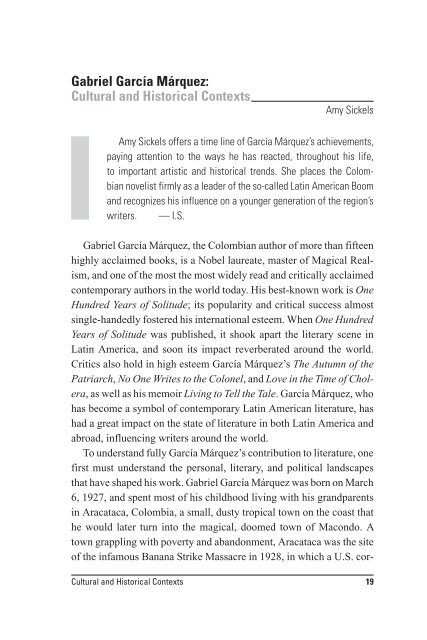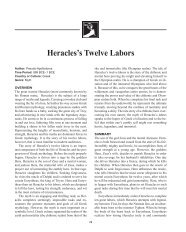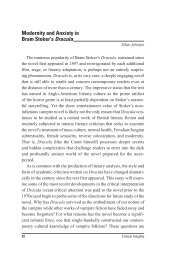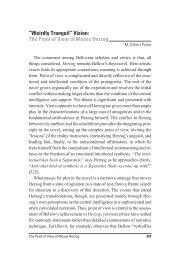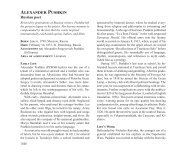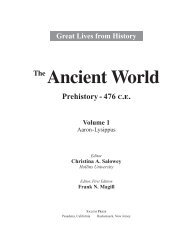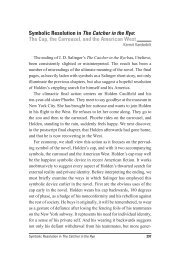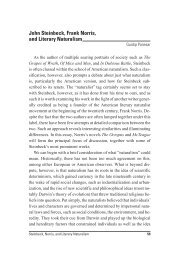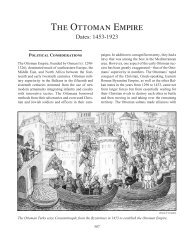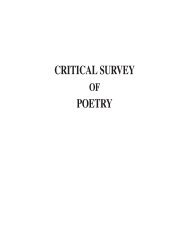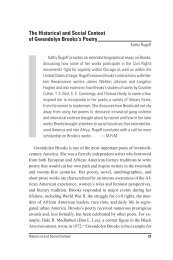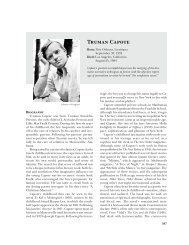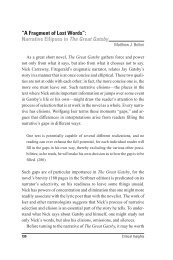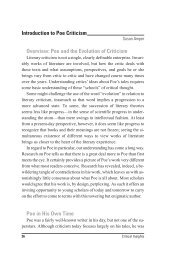Gabriel García Márquez: Cultural and Historical ... - Salem Press
Gabriel García Márquez: Cultural and Historical ... - Salem Press
Gabriel García Márquez: Cultural and Historical ... - Salem Press
You also want an ePaper? Increase the reach of your titles
YUMPU automatically turns print PDFs into web optimized ePapers that Google loves.
<strong>Gabriel</strong> <strong>García</strong> <strong>Márquez</strong>:<br />
<strong>Cultural</strong> <strong>and</strong> <strong>Historical</strong> Contexts<br />
Amy Sickels<br />
Amy Sickels offers a time line of <strong>García</strong> <strong>Márquez</strong>’s achievements,<br />
paying attention to the ways he has reacted, throughout his life,<br />
to important artistic <strong>and</strong> historical trends. She places the Colombian<br />
novelist firmly as a leader of the so-called Latin American Boom<br />
<strong>and</strong> recognizes his influence on a younger generation of the region’s<br />
writers. — I.S.<br />
<strong>Gabriel</strong> <strong>García</strong> <strong>Márquez</strong>, the Colombian author of more than fifteen<br />
highly acclaimed books, is a Nobel laureate, master of Magical Realism,<br />
<strong>and</strong> one of the most the most widely read <strong>and</strong> critically acclaimed<br />
contemporary authors in the world today. His best-known work is One<br />
Hundred Years of Solitude; its popularity <strong>and</strong> critical success almost<br />
single-h<strong>and</strong>edly fostered his international esteem. When One Hundred<br />
Years of Solitude was published, it shook apart the literary scene in<br />
Latin America, <strong>and</strong> soon its impact reverberated around the world.<br />
Critics also hold in high esteem <strong>García</strong> <strong>Márquez</strong>’s The Autumn of the<br />
Patriarch, No One Writes to the Colonel, <strong>and</strong> Love in the Time of Cholera,<br />
as well as his memoir Living to Tell the Tale. <strong>García</strong> <strong>Márquez</strong>, who<br />
has become a symbol of contemporary Latin American literature, has<br />
had a great impact on the state of literature in both Latin America <strong>and</strong><br />
abroad, influencing writers around the world.<br />
To underst<strong>and</strong> fully <strong>García</strong> <strong>Márquez</strong>’s contribution to literature, one<br />
first must underst<strong>and</strong> the personal, literary, <strong>and</strong> political l<strong>and</strong>scapes<br />
that have shaped his work. <strong>Gabriel</strong> <strong>García</strong> <strong>Márquez</strong> was born on March<br />
6, 1927, <strong>and</strong> spent most of his childhood living with his gr<strong>and</strong>parents<br />
in Aracataca, Colombia, a small, dusty tropical town on the coast that<br />
he would later turn into the magical, doomed town of Macondo. A<br />
town grappling with poverty <strong>and</strong> ab<strong>and</strong>onment, Aracataca was the site<br />
of the infamous Banana Strike Massacre in 1928, in which a U.S. cor-<br />
<strong>Cultural</strong> <strong>and</strong> <strong>Historical</strong> Contexts 19
poration, the United Fruit Company, gave consent for the Colombian<br />
army to open fire on a workers’ demonstration, murdering hundreds of<br />
workers. From an early age, <strong>García</strong> <strong>Márquez</strong> was aware of the political<br />
history <strong>and</strong> violence in his country; Colombia, like most Latin American<br />
countries, possesses a complicated, exhausting history of civil<br />
wars, dictators, coups d’état, <strong>and</strong> social revolutions. Yet growing up in<br />
Aracataca was also magical. <strong>García</strong> <strong>Márquez</strong> felt close to his gr<strong>and</strong>father,<br />
a steadfast Liberal who fought in the Thous<strong>and</strong> Days’ War of<br />
1899-1902 <strong>and</strong> would be the subject of his novel No One Writes to the<br />
Colonel. His gr<strong>and</strong>mother also influenced him with her countless stories<br />
of ghosts <strong>and</strong> the dead. Between the violent war memories of his<br />
gr<strong>and</strong>father <strong>and</strong> the fabulous tales of his gr<strong>and</strong>mother, <strong>García</strong> <strong>Márquez</strong><br />
learned the art <strong>and</strong> power of storytelling at a young age.<br />
<strong>García</strong> <strong>Márquez</strong> attended the Universidad Nacional in Bogotá to<br />
study law, but he spent most of his time reading literature <strong>and</strong> writing<br />
stories. A significant influence on his decision to become a writer was<br />
his reading of Franz Kafka’s novella The Metamorphosis. InaParis<br />
Review interview, he told Peter Stone that the first line of the story, in<br />
which Gregor Samsa awakens as a cockroach, “almost knocked me off<br />
the bed I was so surprised. ...WhenIread the line I thought to myself<br />
that I didn’t know anyone was allowed to write things like that. If I had<br />
known, I would have started writing a long time ago” (319). He was<br />
also inspired by the modernists, particularly by Virginia Woolf’s use of<br />
interior monologue <strong>and</strong>, even more important, William Faulkner’s narrative<br />
techniques, themes, <strong>and</strong> small-town settings. <strong>García</strong> <strong>Márquez</strong>’s<br />
first novel, Leaf Storm, is his most Faulknerian in terms of plot pattern<br />
<strong>and</strong> style, echoing the narrative structures of As I Lay Dying <strong>and</strong> The<br />
Sound <strong>and</strong> the Fury. Macondo, the setting of his first four novels <strong>and</strong><br />
One Hundred Years of Solitude, is comparable to Faulkner’s mythical<br />
Yoknapatawpha County.<br />
<strong>García</strong> <strong>Márquez</strong> developed as a writer during one of the most violent<br />
periods in modern Colombian history. After he dropped out of college,<br />
he spent the 1950s writing for various newspapers <strong>and</strong> living in<br />
20 Critical Insights
Europe. In 1955, Leaf Storm was published, marking the beginning of<br />
his literary career; however, not many people read the book, <strong>and</strong> he<br />
continued to make a living by writing for newspapers. He also worked<br />
on In Evil Hour <strong>and</strong> No One Writes to the Colonel, which were directly<br />
influenced by la violencia he had witnessed in Colombia <strong>and</strong> were<br />
more outwardly political than his first novel.<br />
While in Europe, <strong>García</strong> <strong>Márquez</strong> interacted with other writers from<br />
Latin America, each of them regularly publishing work in the principal<br />
Spanish-language literary magazine, Mundo Nuevo. Several of these<br />
figures, including <strong>García</strong> <strong>Márquez</strong>, would make up the so-called Latin<br />
American Boom, a literary movement during the 1960s when Latin<br />
American fiction received much international recognition. The major<br />
players, in addition to <strong>García</strong> <strong>Márquez</strong>, were Julio Cortázar from Argentina,<br />
Carlos Fuentes from Mexico, <strong>and</strong> the Peruvian Mario Vargas<br />
Llosa. Their diverse work produced a superb body of literature that received<br />
impressive critical success <strong>and</strong> attention, <strong>and</strong> now some of<br />
these major novels are considered modern classics in the Hispanic<br />
world, including One Hundred Years of Solitude, Fuentes’s The Death<br />
of Artemio Cruz, Vargas Llosa’s The Green House, <strong>and</strong> Cortázar’s<br />
Hopscotch, all of which are also in the process of being canonized in<br />
American, Latin American, <strong>and</strong> European academia. The Boom authors<br />
were not members of an organized movement, but they were<br />
grouped together as their work became well known around the world.<br />
The Boom authors were influenced by modernism, leftist politics,<br />
<strong>and</strong> Latin American writers from the 1940s <strong>and</strong> 1950s, particularly the<br />
Argentine Jorge Luis Borges <strong>and</strong> Alejo Carpentier from Cuba, whose<br />
fiction reacted against traditional narrative form. Carpentier often used<br />
myths <strong>and</strong> Afro-Indian folk tradition in his work, <strong>and</strong> he is considered<br />
by some to be an early practitioner of Magical Realism. Borges was a<br />
stylistic innovator who employed techniques of detective fiction <strong>and</strong><br />
fantastic literature <strong>and</strong> evoked themes of cyclical time <strong>and</strong> the universe<br />
as labyrinthine. Though <strong>García</strong> <strong>Márquez</strong> <strong>and</strong> other Boom writers disliked<br />
Borges’s conservative politics, his work had a profound impact<br />
<strong>Cultural</strong> <strong>and</strong> <strong>Historical</strong> Contexts 21
on them. In One Hundred Years of Solitude, <strong>García</strong> <strong>Márquez</strong> makes<br />
references to some of his literary forebears, including Borges, Carpentier,<br />
<strong>and</strong> Mexican author Juan Rulfo, who also influenced the style<br />
of Magical Realism with his single book Pedro Páramo.<br />
Politics were of major importance to the Boom writers. The Boom<br />
occurred during the 1960s, between the populist regimes of the 1940s<br />
<strong>and</strong> 1950s, <strong>and</strong> the devastating wave of military dictatorships in the<br />
early to mid-1970s. The 1960s was symbolized in Latin America by<br />
hope <strong>and</strong> cultural innovations, <strong>and</strong> the Cuban Revolution played a big<br />
part in the Boom’s formation. After right-wing dictatorships fell in<br />
both Venezuela <strong>and</strong> Colombia, the defeat of Cuba’s dictator Fulgencio<br />
Batista followed. Fidel Castro had secretly returned to Cuba from exile,<br />
<strong>and</strong> with a small group of followers, including Che Guevara, he<br />
fought against the brutal regime of Batista. On January 8, 1959, Castro<br />
<strong>and</strong> his supporters entered Havana in triumph. Like many Latin American<br />
intellectuals <strong>and</strong> writers, <strong>García</strong> <strong>Márquez</strong> favored the socialist revolution<br />
<strong>and</strong> was an early ally of Castro. During this exciting period of<br />
political <strong>and</strong> cultural changes, a great amount of Latin American literature<br />
appeared, helping to create the Boom.<br />
In the 1960s the success of the Latin American novel was recognized<br />
with zeal in the international world, <strong>and</strong> the Boom writers, including<br />
<strong>García</strong> <strong>Márquez</strong>, helped to develop Latin American literature.<br />
The authors benefited from English translations <strong>and</strong> the fact that their<br />
books were published in Europe <strong>and</strong> by Harper & Row in the United<br />
States, which helped to widen the readership. There were also important<br />
publishing houses based in Buenos Aires, Mexico City, Havana,<br />
<strong>and</strong> Santiago, Latin <strong>and</strong> South American cities that became strong<br />
cultural centers during this period. Furthermore, American <strong>and</strong> European<br />
universities began teaching the Latin American Boom authors,<br />
<strong>and</strong> scholars <strong>and</strong> critics took an interest in their work. Though the<br />
Boom writers’ styles were quite different, many of their literary ideas<br />
were similar, as they experimented with forms of realism <strong>and</strong> narrative<br />
structure. The four main writers of the Boom—<strong>García</strong> <strong>Márquez</strong>,<br />
22 Critical Insights
Cortázar, Fuentes, <strong>and</strong> Vargas Llosa—along with several others, began<br />
to enjoy critical <strong>and</strong> commercial success both in Spanish <strong>and</strong> in translation.<br />
Before One Hundred Years of Solitude, <strong>García</strong> <strong>Márquez</strong> wrote four<br />
books: Leaf Storm, Big Mama’s Funeral, No One Writes to the Colonel,<br />
<strong>and</strong> In Evil Hour, for which he won the Esso Prize, a literary prize in<br />
Mexico. He was not well known outside of his small circle, however,<br />
<strong>and</strong> no one could have predicted the impact he would have on literature<br />
or foresee the international fame that was in his near future. After the<br />
Cuban Revolution, <strong>García</strong> <strong>Márquez</strong> was living with his family in Mexico,<br />
earning money by writing film scripts. He had not written any fiction<br />
for about six years. Then in 1965 he isolated himself to write the<br />
complete story of Macondo, which had been building in his head for so<br />
long that he wrote the novel in eighteen months. The novel chronicles<br />
the saga of the Buendías living in the mythical town of Macondo; as<br />
the town progresses from a primitive village to a modern town, it also<br />
suffers from the troubles experienced in Colombian (<strong>and</strong> Latin American)<br />
history.<br />
Fellow Boom author Carlos Fuentes followed the development of<br />
the book closely <strong>and</strong> wrote an influential article in Mundo Nuevo praising<br />
the book before its publication, yet he too would be astounded by<br />
its runaway success. One Hundred Years of Solitude first appeared in<br />
Buenos Aires, Argentina, in 1967, <strong>and</strong>, in Vargas Llosa’s words, its arrival<br />
provoked “a literary earthquake throughout Latin America.” The<br />
publisher began with a modest printing of eight thous<strong>and</strong> copies, far<br />
more than any of <strong>García</strong> <strong>Márquez</strong>’s others novels, <strong>and</strong> then quickly<br />
added new editions after the initial run was sold out within hours. In<br />
Latin America, <strong>García</strong> <strong>Márquez</strong> had become famous overnight; he was<br />
regarded as if he were a legendary soccer player or singer. When he<br />
visited Buenos Aires shortly after the book’s release, people shouted<br />
support <strong>and</strong> applauded him.<br />
Over the next two years, <strong>García</strong> <strong>Márquez</strong>’s fame grew exponentially,<br />
not only in Latin America but throughout the international com-<br />
<strong>Cultural</strong> <strong>and</strong> <strong>Historical</strong> Contexts 23
munity. Sales of One Hundred Years of Solitude skyrocketed, <strong>and</strong><br />
awards <strong>and</strong> honors rained down on the author. The novel has been<br />
translated into more than thirty languages <strong>and</strong> has sold more than<br />
twenty million copies; its critical acclaim <strong>and</strong> popularity have forever<br />
changed <strong>García</strong> <strong>Márquez</strong>’s life. An epic novel about memory, community,<br />
myth, history, <strong>and</strong> nostalgia, One Hundred Years of Solitude is<br />
considered by many critics to be the greatest of all Latin American<br />
novels, with the story of the Buendía family functioning as a metaphor<br />
for the history of Latin America. Critic Gene H. Bell-Villada praises<br />
the novel “as a glorious instance of literature’s possibilities, of what<br />
prose narrative can do for our imaginations <strong>and</strong> emotions, our politics<br />
<strong>and</strong> pleasures, our knowledge of life <strong>and</strong> our sense of humor” (204).<br />
The novel examines native <strong>and</strong> popular cultures as valid forms of<br />
knowledge <strong>and</strong> depicts the tension between the written <strong>and</strong> the oral<br />
word. Critics have praised the work as “biblical” in its scope, an epic<br />
that has delighted readers across the world, taking them through one<br />
hundred years of the lives of the Buendía family.<br />
Unlike the other books of the Boom, One Hundred Years of Solitude<br />
moved beyond an academic audience <strong>and</strong> elite writing circles to reach<br />
popular audiences across the world. In Latin America, <strong>García</strong> <strong>Márquez</strong><br />
gave literature to the people, as people from all socioeconomic classes<br />
<strong>and</strong> various backgrounds were reading the book <strong>and</strong> recognizing their<br />
world. Though several Boom authors were important during this period,<br />
One Hundred Years of Solitude was the only book that truly won<br />
popular <strong>and</strong> critical success. Immensely popular with Latin Americans,<br />
the novel also transcended any notion of regionalism, <strong>and</strong> it soon<br />
captured international attention.<br />
<strong>García</strong> <strong>Márquez</strong>’s technique for writing One Hundred Years of Solitude<br />
had a significant impact on contemporary literature, both in Latin<br />
America <strong>and</strong> around the world. <strong>García</strong> <strong>Márquez</strong> is often credited as the<br />
master of Magical Realism, the literary technique in which no distinction<br />
is made between reality <strong>and</strong> the fantastic. Magical Realism is a<br />
somewhat vague literary label that has been applied to many writers,<br />
24 Critical Insights
including Franz Kafka, Salman Rushdie, Borges, Italo Calvino, Günter<br />
Grass, <strong>and</strong> Julio Cortázar, but <strong>García</strong> <strong>Márquez</strong> has emerged as the<br />
name most associated with the style. The movement itself is typically<br />
credited to <strong>García</strong> <strong>Márquez</strong>, although aspects of the technique appeared<br />
earlier, most notably in the work of Alejo Carpentier.<br />
When he was working on the novel, <strong>García</strong> <strong>Márquez</strong>, who repudiates<br />
fantasy writing, did not set out to write a “Magical Realist novel.”<br />
He simply wanted to capture the stories of his gr<strong>and</strong>mother <strong>and</strong> the<br />
calm tone of her voice, without leaving the realm of reality. He has often<br />
said that if a writer makes something specific enough, he can make<br />
the reader believe anything, no matter how fantastic or exaggerated.<br />
For example, he told Peter Stone that he struggled with the scene of<br />
Remedios the Beauty ascending to heaven. Then one day he went outside<br />
<strong>and</strong> saw a woman hanging up the sheets to dry on a windy day: “I<br />
discovered that if I used the sheets for Remedios the Beauty, she would<br />
ascend. That’s how I did it, to make it credible. The problem for every<br />
writer is credibility. Anybody can write anything so long as it’s believed”<br />
(324). In Latin America, he has explained, Magical Realism is<br />
perfectly ordinary—the strangest, oddest things happen every day. By<br />
incorporating mythical elements into realistic fiction, <strong>García</strong> <strong>Márquez</strong><br />
reveals both past <strong>and</strong> present problems in Latin America.<br />
Most critics consider One Hundred Years of Solitude the greatest<br />
novel of the Boom, even though it may not be as structurally or technically<br />
complex as some of the other Boom books. Critic Philip Swanson<br />
considers the work to be more of a transition book, from Boom to Post-<br />
Boom. He argues that it contains many features of typical Boom books,<br />
including radical questioning of the nature of reality <strong>and</strong> literature’s<br />
ability to describe it, yet is also a mostly linear narrative <strong>and</strong> an entertaining<br />
novel, which breaks with the elitism of typical Boom writing:<br />
“The novel, in other words, posits on the one h<strong>and</strong> a complex literaryintellectual<br />
problemization of the relationship between literature <strong>and</strong><br />
reality; while on the other h<strong>and</strong>, it seeks to put forward a popular <strong>and</strong> in<br />
some ways authentically Latin American demystification of literature<br />
<strong>Cultural</strong> <strong>and</strong> <strong>Historical</strong> Contexts 25
<strong>and</strong> reality” (86). No other book in the Boom garnered such support or<br />
popularity; it was a novel that had a significant impact on scholarship<br />
<strong>and</strong> readership around the world.<br />
By the early 1970s, the unity among the writers of the Boom began<br />
to dissipate, <strong>and</strong> some of them were no longer friends or political allies.<br />
The hopeful myth that surrounded the Cuban Revolution began to fade<br />
away, symbolized when the poet Heberto Padilla was arrested in 1971,<br />
inciting an outrage. Sixty intellectuals who had supported the revolution<br />
signed an open letter to Fidel Castro, dem<strong>and</strong>ing Padilla’s release.<br />
Several Boom authors, including <strong>García</strong> <strong>Márquez</strong>, signed the letter.<br />
Though the Boom reached its end, the major writers continued with<br />
stellar careers that show no signs of diminishing.<br />
After the momentous success of One Hundred Years of Solitude,<br />
critics <strong>and</strong> audiences eagerly awaited <strong>García</strong> <strong>Márquez</strong>’s next book. Initially,<br />
he planned to write this novel in a year; it actually took seven,<br />
during which time his fame continued to burgeon at a rapid speed. The<br />
long-awaited The Autumn of the Patriarch was published in 1975 <strong>and</strong><br />
quickly sold half a million copies; however, its dense, difficult prose<br />
turned off many readers who had hoped to return to the magical world<br />
of Macondo. Structured in six unnumbered chapters comprising long,<br />
dense sentences, without separate paragraphs, it is a difficult book <strong>and</strong><br />
somewhat inaccessible. Some critics also expressed disappointment at<br />
first; however, over time, opinion has changed <strong>and</strong> many consider this<br />
novel to be a major work of <strong>García</strong> <strong>Márquez</strong>’s oeuvre as well as of contemporary<br />
Latin American fiction. “All of his works are well crafted;<br />
this novel is his most refined project of technical virtuosity,” attests<br />
critic Raymond Leslie Williams (100).<br />
During the late 1960s <strong>and</strong> early 1970s, several writers of the Boom<br />
published novels about dictators, a powerful subject for the region, as<br />
Latin America has a painful, long-st<strong>and</strong>ing history of tyrannical dictatorships.<br />
For example, in 1973 the democratically elected president of<br />
Chile, Salvador Allende, was overthrown <strong>and</strong> replaced by General<br />
Augusto Pinochet, a dictator who remained in power until the end of<br />
26 Critical Insights
the 1980s <strong>and</strong> was infamous for torture <strong>and</strong> human rights abuses. The<br />
Autumn of the Patriarch is based on several dictators in Latin America.<br />
The General, the main character, is dead from the first line of the text,<br />
<strong>and</strong> the rest of the novel is told in flashbacks <strong>and</strong> a series of anecdotes<br />
that relate to the General, with none of them appearing in chronological<br />
order. Writing this novel allowed <strong>García</strong> <strong>Márquez</strong> to distance himself<br />
from the literary world of Macondo <strong>and</strong> also proved to critics his<br />
wide range of literary style <strong>and</strong> technical experimentation.<br />
After this publication, <strong>García</strong> <strong>Márquez</strong> returned to journalism. In<br />
1980, he began writing columns dealing with such subjects as the “disappearances”<br />
of intellectuals under the Argentine military regime, articles<br />
that were syndicated in a couple of dozen Latin American newspapers<br />
<strong>and</strong> magazines. His dedication to journalism has influenced many<br />
young journalists <strong>and</strong> writers in Latin America. In 1999, he purchased<br />
a struggling Colombian newsmagazine, Cambio, with his Nobel Prize<br />
money, <strong>and</strong> today the magazine continues to thrive. <strong>García</strong> <strong>Márquez</strong>’s<br />
devotion to journalism <strong>and</strong> nurturing of young journalists is symbolized<br />
by his founding of the New Journalism Foundation, which has a<br />
school in Cartagena, Colombia, <strong>and</strong> sponsors workshops <strong>and</strong> scholarships<br />
throughout Latin America. His major link to journalism is politics,<br />
which has always informed not only his outlook on the world but<br />
also his writing.<br />
Though it is for his long-lasting impact on literature that <strong>García</strong><br />
<strong>Márquez</strong> is most widely known, he is also famous for his political ideologies<br />
<strong>and</strong> journalistic background. <strong>García</strong> <strong>Márquez</strong> has always been<br />
outspoken about politics. Early on in his career, he committed himself<br />
to several years of vigorous journalistic activity in support of revolution,<br />
<strong>and</strong> over the years, his fame <strong>and</strong> journalism have provided a platform<br />
from which he can fight against human injustices <strong>and</strong> support<br />
leftist causes. He has been outspoken about U.S. involvement in Colombia<br />
<strong>and</strong> other Latin America countries, <strong>and</strong> for many years he was<br />
denied a visa by the U.S. government. Though <strong>García</strong> <strong>Márquez</strong> is well<br />
respected for serving as an intermediary between governments <strong>and</strong><br />
<strong>Cultural</strong> <strong>and</strong> <strong>Historical</strong> Contexts 27
evolutionaries, he is often criticized in Latin America for remaining<br />
close to Castro; unlike many artists <strong>and</strong> writers who later changed their<br />
views about the Castro regime, <strong>García</strong> <strong>Márquez</strong> has always supported<br />
the Cuban Revolution.<br />
Though <strong>García</strong> <strong>Márquez</strong> is a social critic in his fiction <strong>and</strong> assertively<br />
leftist in politics, his fiction is not didactic or overtly political.<br />
Turning to journalism instead of fiction to deal directly with political<br />
<strong>and</strong> social issues, <strong>García</strong> <strong>Márquez</strong> rejects social-protest literature, believing<br />
it limits artistic expression <strong>and</strong> freedom. Yet nearly all of his<br />
work addresses social-political concerns in some way—though often<br />
subtly. His fiction examines the realities of late-colonial <strong>and</strong> postcolonial<br />
history <strong>and</strong> cultures in the Americas while also exploring the<br />
truths <strong>and</strong> myths of national histories. Though critics focus on the<br />
Magical Realism of his work, <strong>García</strong> <strong>Márquez</strong> claims he writes “socialist<br />
realism,” <strong>and</strong> critic Raymond Williams agrees: “One Hundred<br />
Years of Solitude might seem at first like a book of fantasy, but it is one<br />
of the most historical books of the Boom <strong>and</strong> it abounds in social <strong>and</strong><br />
political implications” (96). Constant political discontent, national instability,<br />
<strong>and</strong> Colombian history <strong>and</strong> myths have shaped not only<br />
<strong>García</strong> <strong>Márquez</strong>’s ideology but also the gr<strong>and</strong> scope <strong>and</strong> depth of his<br />
fiction.<br />
After a focus on journalism, <strong>García</strong> <strong>Márquez</strong> broke his literary silence<br />
with the publication of the highly acclaimed short novel Chronicle<br />
of a Death Foretold, based on a 1951 newspaper article involving<br />
honor <strong>and</strong> death in Colombia. Two million copies were printed in Colombia,<br />
Argentina, Spain, <strong>and</strong> Mexico. The novel, which consists of<br />
five untitled chapters, explores why an entire town allows a senseless<br />
murder to occur. It uses many conventions of the classical detective<br />
genre but also subverts these conventions <strong>and</strong> presents the sequence of<br />
events in reverse.<br />
On December 5, 1985, a million copies of Love in the Time of Cholera<br />
were released in the world’s four most populous Spanish-speaking<br />
countries. This book, one of <strong>García</strong> <strong>Márquez</strong>’s most popular, is a love<br />
28 Critical Insights
story based on his parents’ courtship. One of his most straightforward<br />
<strong>and</strong> accessible narratives, it is also rich <strong>and</strong> artistic, <strong>and</strong> it received<br />
prominent critical praise in Latin America, Europe, <strong>and</strong> the United<br />
States—in the last, most notably with an enthusiastic review by the recluse<br />
novelist Thomas Pynchon in The New York Times Book Review.<br />
The novel, an extensive narrative, is also an intentional re-creation<br />
of romantic nineteenth-century realism. The plot follows the love story<br />
of Florentino Ariza <strong>and</strong> Fermina Daza over the course of sixty years,<br />
<strong>and</strong> love <strong>and</strong> aging are the main themes. The story is told by a single<br />
narrative voice, <strong>and</strong> the structure incorporates several temporal<br />
planes.<br />
From 1989 through the 1990s, <strong>García</strong> <strong>Márquez</strong> published several<br />
highly acclaimed works of fiction <strong>and</strong> nonfiction, including The General<br />
in His Labyrinth, based on the life of Simón Bolívar; Strange Pilgrims,<br />
a collection of stories; <strong>and</strong> a well-received novel, Love <strong>and</strong><br />
Other Demons, which centers on the transferring of burial remains<br />
from the crypt of an old convent, something the author had witnessed<br />
as a child. This was followed in 1996 with a work of journalism detailing<br />
the atrocities of the Colombian drug trade, News of a Kidnapping.<br />
In 2003, Knopf released the English translation of Living to Tell the<br />
Tale, the first of three projected volumes of memoirs. Living to Tell the<br />
Tale takes the reader from <strong>García</strong> <strong>Márquez</strong>’s birth in Aracataca through<br />
his years as a journalist <strong>and</strong> artist in the 1950s.<br />
For more than forty years, <strong>García</strong> <strong>Márquez</strong> has had a great impact<br />
on the scholarly <strong>and</strong> academic worlds. Numerous studies have been<br />
written about his work, both in Latin America <strong>and</strong> throughout the international<br />
community. One impressive early study was written by Mario<br />
Vargas Llosa; titled <strong>García</strong> <strong>Márquez</strong>: Historia de un deicidio, itisa<br />
650-page examination of One Hundred Years of Solitude. Although for<br />
a number of years the majority of the scholarly attention focused on<br />
One Hundred Years of Solitude, hundreds of books <strong>and</strong> articles have<br />
now been published analyzing all of <strong>García</strong> <strong>Márquez</strong>’s work. In the<br />
United States, many scholarly <strong>and</strong> critical studies have emerged in the<br />
<strong>Cultural</strong> <strong>and</strong> <strong>Historical</strong> Contexts 29
past fifteen years; important critics include Gene H. Bell-Villada, Steven<br />
Boldy, Harley Oberhelman, <strong>and</strong> Raymond Williams.<br />
<strong>García</strong> <strong>Márquez</strong> has been honored with the highest awards for his<br />
writing from the international community. One Hundred Years of Solitude<br />
won the Chianchiano Prize in Italy <strong>and</strong> the prestigious Rómulo<br />
Gallegos Prize. In 1981 <strong>García</strong> <strong>Márquez</strong> was awarded the French Legion<br />
of Honor, <strong>and</strong> in 1982 he received the Nobel Prize in Literature,<br />
the most prestigious recognition possible for a major writer. He was the<br />
fourth Latin American to win a Nobel Prize <strong>and</strong> the first Colombian.<br />
Colombia went wild with excitement, sending <strong>García</strong> <strong>Márquez</strong> off to<br />
accept the prize with an entourage of sixty dancers <strong>and</strong> musical performers<br />
to bring a tropical celebration to Sweden. <strong>García</strong> <strong>Márquez</strong> delivered<br />
a moving speech about the political tragedies of Latin America,<br />
<strong>and</strong> the Nobel Committee acknowledged <strong>García</strong> <strong>Márquez</strong> for his<br />
global readership <strong>and</strong> humanitarianism.<br />
<strong>García</strong> <strong>Márquez</strong>’s influence on other writers in Latin America, the<br />
United States, Europe, <strong>and</strong> across the globe has been significant <strong>and</strong><br />
lasting. In the United States, <strong>García</strong> <strong>Márquez</strong> has been well received,<br />
to say the least. Before the Boom, in the twentieth century, it was typically<br />
the French who influenced American writers. When One Hundred<br />
Years of Solitude appeared in translation in the United States, it<br />
was something new <strong>and</strong> wholly different. American reviews of <strong>García</strong><br />
<strong>Márquez</strong>’s work are typically positive, <strong>and</strong> writers such as Robert<br />
Coover <strong>and</strong> John Barth have praised One Hundred Years of Solitude as<br />
brilliant literature. <strong>García</strong> <strong>Márquez</strong>’s work has influenced such highly<br />
acclaimed American authors as Anne Tyler, Jonathan Safran Foer, Oscar<br />
Hijuelos, <strong>and</strong> fellow Nobel laureate Toni Morrison. Morrison’s<br />
writing in particular, which focuses on the experiences of African<br />
Americans, blends fantastical <strong>and</strong> mythical elements with realistic depictions<br />
of racial, gender, <strong>and</strong> class conflict. The influences of both<br />
<strong>García</strong> <strong>Márquez</strong> <strong>and</strong> Faulkner are apparent in such Morrison novels as<br />
Song of Solomon <strong>and</strong> Beloved, in which the heavy weight of the past<br />
presses down on present reality.<br />
30 Critical Insights
<strong>García</strong> <strong>Márquez</strong>’s literary influence also extends far beyond the<br />
United States. For example, his works have had an impact on British<br />
Indian novelist Salman Rushdie, whose novels weave mythology, pop<br />
culture, politics, <strong>and</strong> religions from around the world. <strong>García</strong> <strong>Márquez</strong><br />
has also been a major influence on contemporary Chinese fiction, <strong>and</strong><br />
echoes of his style can be detected in the work of the Nigerian poet <strong>and</strong><br />
novelist Ben Okri, who describes both the mundane <strong>and</strong> the metaphysical.<br />
The success of the Latin American Boom helped set the stage for the<br />
postmodern novel <strong>and</strong> the Post-Boom novel. The Boom itself changed<br />
the way Latin American culture <strong>and</strong> arts are perceived around the<br />
world <strong>and</strong> opened doors for many new writers. One Hundred Years of<br />
Solitude in particular, as a culmination of a modernist project, influenced<br />
the Latin American postmodern novel. Like Borges’s work,<br />
<strong>García</strong> <strong>Márquez</strong>’s writing was revolutionary <strong>and</strong> affirmed the power of<br />
invention. Of all the Boom writers in his generation, only <strong>García</strong> <strong>Márquez</strong><br />
was a true Magical Realist. Now the stereotype that all Latin<br />
American fiction involves Magical Realism pervades much popular<br />
<strong>and</strong> critical opinion, which testifies to the strength of <strong>García</strong> <strong>Márquez</strong>’s<br />
literary reputation. The critic Bell-Villada attests, “Because of the<br />
enormous reach of his reputation, <strong>García</strong> <strong>Márquez</strong> is now seen not just<br />
as another major author but as the prime symbol of the surge of creativity<br />
in Latin American letters in our time” (203).<br />
In Latin America, writers cannot escape <strong>García</strong> <strong>Márquez</strong>’s looming<br />
shadow, <strong>and</strong> his popularity <strong>and</strong> success are viewed as both blessing <strong>and</strong><br />
curse. The style of Magical Realism is apparent in the work of writers<br />
such as Luisa Valenzuela <strong>and</strong> Isabel Allende, one of the first successful<br />
women novelists in Latin America. Allende’s novels often focus on the<br />
experiences of women, weaving together myth <strong>and</strong> realism. The House<br />
of the Spirits (1982) concerns a cast of bizarre characters telling a story<br />
that covers several generations <strong>and</strong> includes psychic abilities, ghosts,<br />
<strong>and</strong> strange accidents. Allende is often compared to <strong>García</strong> <strong>Márquez</strong>,<br />
<strong>and</strong> critics have analyzed The House of the Spirits as a unique rework-<br />
<strong>Cultural</strong> <strong>and</strong> <strong>Historical</strong> Contexts 31
ing of One Hundred Years of Solitude. Many Latin American authors<br />
have tried to free themselves from the shadow of <strong>García</strong> <strong>Márquez</strong> <strong>and</strong><br />
from Magical Realism, including the critically acclaimed writers José<br />
Manuel Prieto, Horacio Castellanos Moya, <strong>and</strong> Francisco Goldman.<br />
Other Post-Boom authors include Antonio Skármeta, Rosario Ferré,<br />
<strong>and</strong> Gustavo Sainz, who have typically used a simpler, more readable<br />
style than the Boom authors or have returned to realism. Yet almost all<br />
Latin American writers have learned from <strong>García</strong> <strong>Márquez</strong>’s imaginative<br />
oeuvre, <strong>and</strong>, in fact, he galvanized Colombian literature in a way<br />
that was unprecedented. For many writers in Latin America, <strong>García</strong><br />
<strong>Márquez</strong> was the masterful Latin American writer of their youth, a<br />
hero <strong>and</strong> mentor who inspired many to pick up a pen. He raised the bar<br />
high with the quality of his novels, however, <strong>and</strong> each succeeding generation<br />
of Latin America authors runs the danger of being pigeonholed<br />
as writers of Magical Realism.<br />
In Colombia <strong>and</strong> throughout much of Latin America, <strong>García</strong> <strong>Márquez</strong><br />
is an icon. In Colombia, everyone knows who he is, <strong>and</strong> most people<br />
have read One Hundred Years of Solitude, or at least a story or<br />
newspaper article written by him; his work is very much in the public<br />
realm. <strong>García</strong> <strong>Márquez</strong> has greatly affected the reading public, specifically<br />
Latin Americans, who immediately respond to <strong>and</strong> recognize the<br />
world that he presents as their world—the social <strong>and</strong> cultural reality,<br />
<strong>and</strong> the specific history of their countries. Yet his work is also widely<br />
appreciated around the world by readers who can identify with the solitude<br />
suffered in modern times.<br />
When One Hundred Years of Solitude was published, it first took<br />
Latin America by storm, <strong>and</strong> then the world, becoming an international<br />
best seller <strong>and</strong> establishing <strong>García</strong> <strong>Márquez</strong> as an inventive, epic novelist.<br />
No South American writer or literary novel from South America<br />
had ever had such an impact. One Hundred Years of Solitude <strong>and</strong><br />
<strong>García</strong> <strong>Márquez</strong>’s diverse, acclaimed work that followed have inspired<br />
a vast array of critical scholarship <strong>and</strong> inspired readers from around the<br />
world. <strong>García</strong> <strong>Márquez</strong> is considered one of the most significant au-<br />
32 Critical Insights
thors of the twentieth century, <strong>and</strong> his work has influenced ideas about<br />
the novel, the technique of Magical Realism, <strong>and</strong> the power of imagination.<br />
It is difficult to imagine the contemporary novel without <strong>García</strong><br />
<strong>Márquez</strong>. One of the most famous, beloved, <strong>and</strong> critically acclaimed<br />
literary writers alive today, <strong>García</strong> <strong>Márquez</strong> has greatly contributed to<br />
<strong>and</strong> rejuvenated contemporary literature.<br />
Works Cited<br />
Bell-Villada, Gene H. <strong>García</strong> <strong>Márquez</strong>: The Man <strong>and</strong> His Work. Chapel Hill: U of<br />
North Carolina P, 1990.<br />
Stone, Peter. “<strong>Gabriel</strong> <strong>García</strong> <strong>Márquez</strong>.” Writers at Work: The Paris Review Interviews—Sixth<br />
Series. Ed. George Plimpton. New York: Viking, 1984. 313-39.<br />
Swanson, Philip. “The Post-Boom Novel.” The Cambridge Companion to the<br />
Latin American Novel. Ed. Efraín Kristal. New York: Cambridge UP, 2005. 81-<br />
101.<br />
Vargas Llosa, Mario. <strong>García</strong> <strong>Márquez</strong>: Historia de un deicidio. Barcelona: Barral<br />
Editores, 1971.<br />
Williams, Raymond Leslie. The Modern Latin American Novel. New York: Twayne,<br />
1998.<br />
<strong>Cultural</strong> <strong>and</strong> <strong>Historical</strong> Contexts 33


